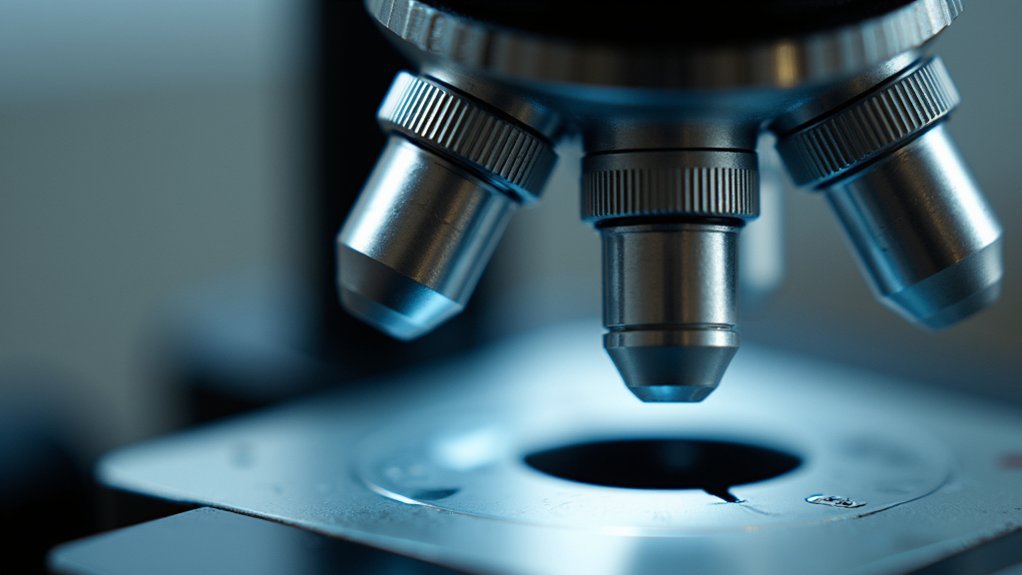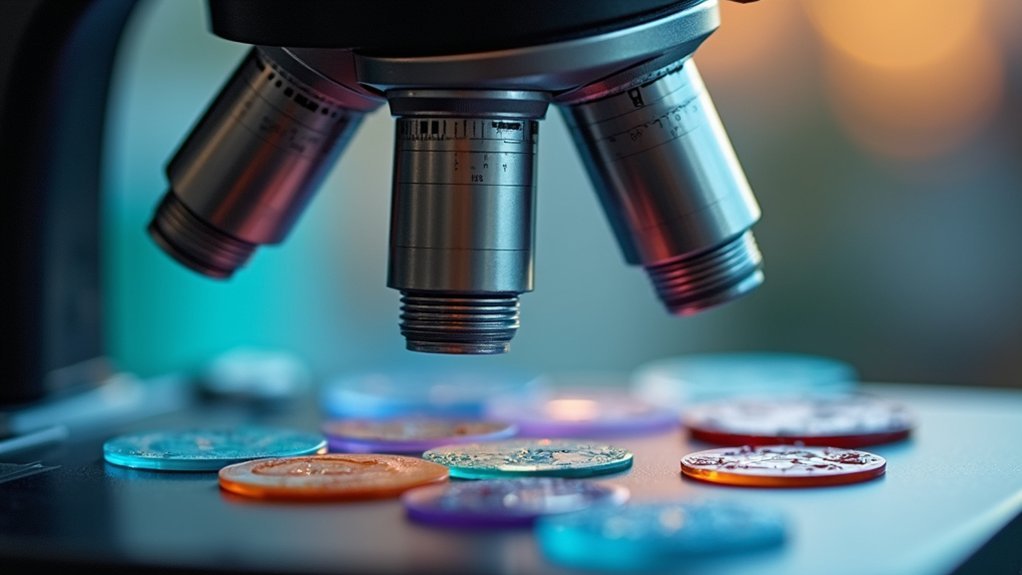For microscope focus issues: 1) Adjust the tension in your coarse focus knob by turning the adjustment screw clockwise to tighten or counter-clockwise to loosen. 2) Fix stage drift by cleaning the stage area and performing regular tension checks monthly. 3) Consider upgrading to dual-speed focus controls for smoother, more precise adjustments at high magnifications. These simple adjustments will transform your viewing experience and extend your instrument’s lifespan.
Adjusting Tension in Microscope Focus Mechanisms

Mastering the tension in your microscope’s focus mechanism prevents frustrating stage drift and guarantees precise observations.
For compound microscopes, locate the tension adjustment screw inside the coarse focus knob and turn clockwise to tighten or counter-clockwise to loosen.
When working with a stereo microscope, insert the small tension focus adjustment tool between the focusing holder and knob to achieve your desired resistance.
To protect the internal gearing, hold one focus knob stationary while adjusting the other.
Regular tension checks maintain stable viewing and prevent focusing difficulties.
Performing regular tension adjustments preserves microscope function and ensures consistently clear, drift-free observations.
The coarse focus knob should move smoothly without slipping, while fine adjustment controls should maintain their position when released.
Always consult your microscope’s manual for model-specific instructions, as adjustment methods vary by manufacturer.
Resolving Stage Drift With Proper Maintenance
When your microscope’s stage gradually sinks or shifts during observation, you’re experiencing stage drift—a common frustration that disrupts critical viewing. The culprit is often a loose focus mechanism that needs attention.
To fix this issue, locate the tension adjustment inside the coarse focus knob. Turn it clockwise to tighten the mechanism, which prevents unwanted movement while maintaining smooth operation. If you’re struggling with a stuck mechanism, don’t force it—you’ll risk damaging internal gears.
Regular maintenance is your best defense against stage drift. Check tension adjustments monthly and clean the stage area to remove debris that might interfere with proper function.
Always consult your microscope’s manual for specific fine focus adjustment procedures—each model has unique requirements that affect performance and longevity.
Upgrading to Dual-Speed Focus Controls

Researchers seeking enhanced precision can greatly improve their microscope’s performance by upgrading to dual-speed focus controls. These systems offer a significant advantage with their 10:1 fine focus ratio, allowing for more accurate adjustments particularly when working at higher magnifications.
Before purchasing an upgrade, you’ll need to verify compatibility with your specific microscope model. Some instruments may require replacing the entire focuser.
Dual-speed Crayford focusers are popular options that provide smooth, backlash-free operation.
For even greater control, consider integrating an electronic focusing system with your dual-speed controls. Many users report substantial improvements in usability without the need for manual adjustments.
When performing the upgrade, handle components carefully to avoid damaging your existing equipment. Patience during installation will guarantee ideal results.
Frequently Asked Questions
What Is the Fastest Way to Focus Your Microscope?
You should start with the coarse focus knob at low magnification to bring your specimen into general view, then switch to fine focus for precise clarity. Always center your slide properly.
How to Fix Microscope Focus?
To fix your microscope focus, adjust the tension knob, clean your objective lens, use only fine focus at high magnifications, verify proper coverslip thickness, and perform regular maintenance on stuck gears as needed.
What Should You Do if You Can’t Focus the Specimen at 40X?
If you can’t focus at 40x, check your slide’s cover slip thickness (0.17mm), clean the lens, verify it’s a dry objective, and try focusing on paper. If problems persist, inspect for internal damage.
What Should You Do if You Can’t Find or Clearly Focus Your Microscope Slide?
If you can’t find or focus your slide, start at lowest magnification, check slide placement, adjust coarse focus first, then fine focus. Test on flat paper to determine if it’s the microscope or specimen.
In Summary
You’ve now learned three essential microscope focus fixes that’ll transform your lab experience. By adjusting coarse focus tension, preventing stage drift through regular cleaning, and upgrading to dual-speed controls, you’ll achieve precision without frustration. Don’t let focus issues compromise your research quality—implement these quick solutions today. With these simple techniques, you’ll extend your microscope’s life while capturing clearer, more reliable images for your important work.





Leave a Reply